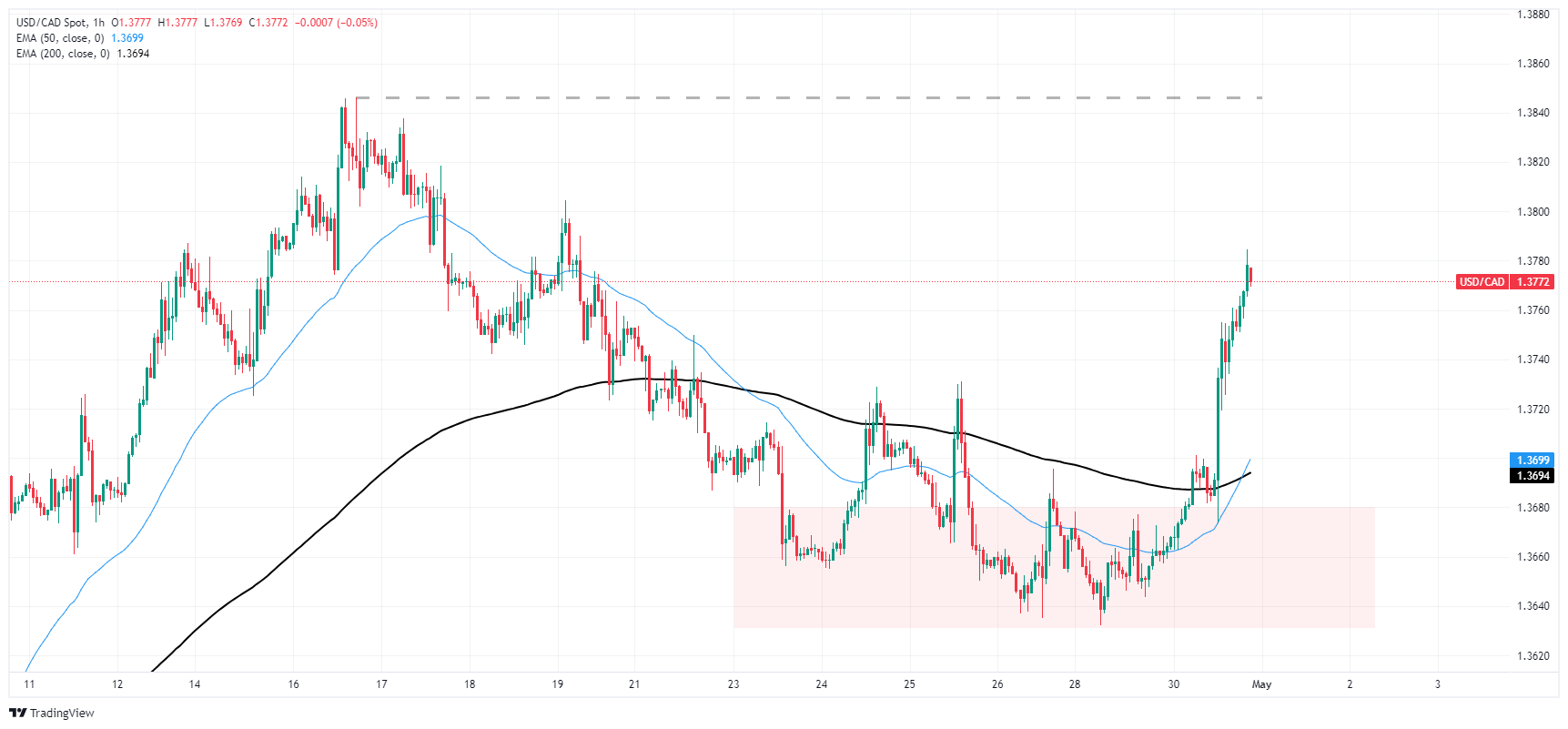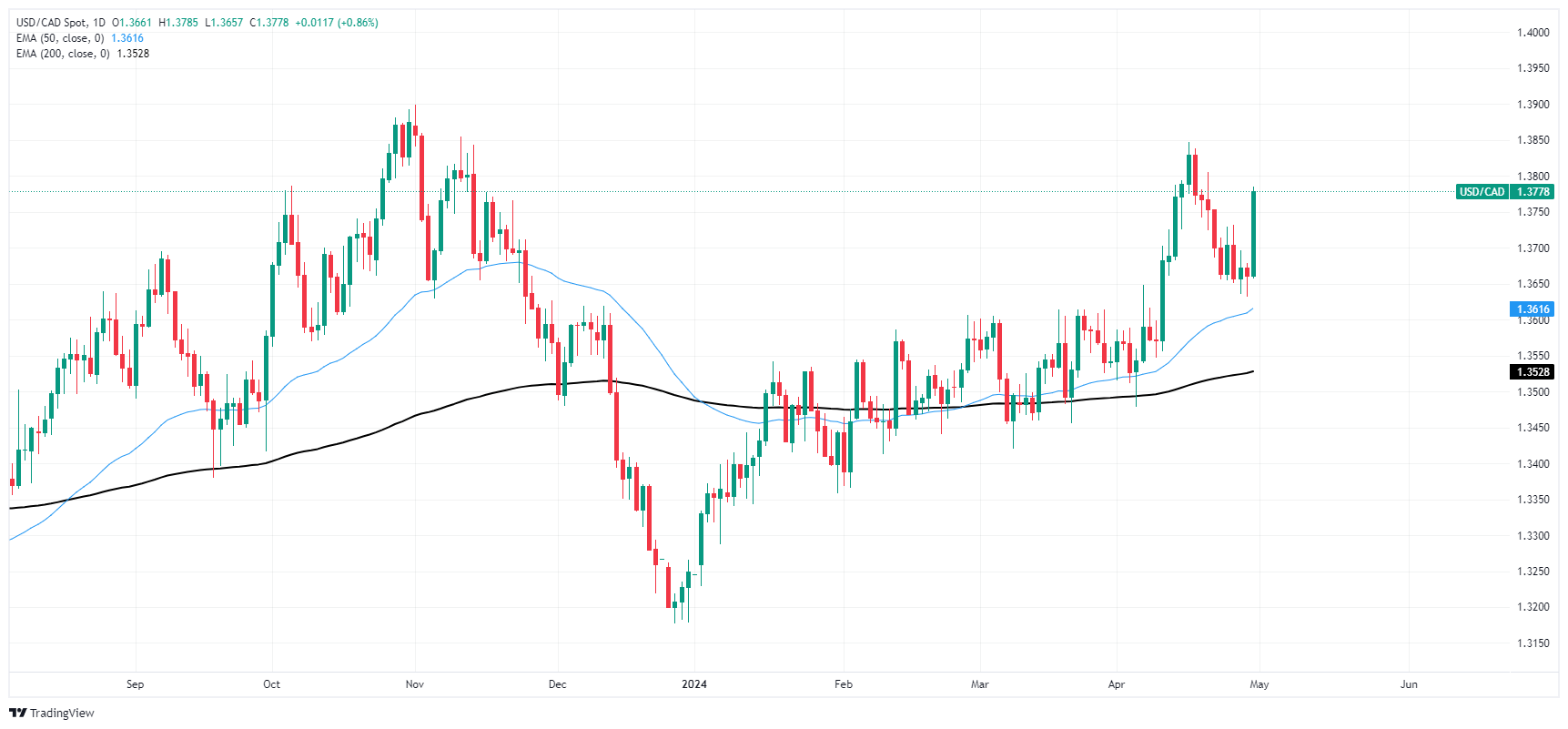- Canadian Dollar retreats after US morning session’s risk-off jitters.
- Canada GDP prints below expectations, erodes CAD further.
- US wage growth accelerates again, crimping rate cut hopes.
The Canadian Dollar (CAD) eased against the Greenback on Tuesday after the American market session kicked the day off with a risk-off push after US wages outpaced expectations. Investors are gearing up for the US Federal Reserve’s (Fed) latest rate call, slated for Wednesday.
Canada saw a further slowing in Gross Domestic Product (GDP) figures in February, further hampering the Canadian Dollar. Declines in the Antipodeans gave the CAD a boost in Pacific markets, sending the Canadian Dollar into another mixed trading day.
Daily digest market movers: Canadian Dollar retreats in wake of Greenback jump
- Canadian MoM GDP in February rose 0.2%, below the forecast for 0.3% and falling back from January’s 0.5% (revised down from 0.6%).
- US Q1 Employment Cost Index accelerated to 1.2%, beating the forecast of 1.0% and the previous quarter’s 0.9% wage growth.
- Accelerating labor costs continue to plague rate-cut-hungry markets as inflation remains above Fed targets and progress on reducing price growth has stalled.
- April’s Chicago Purchasing Managers Index (PMI) eased to 37.9, the indicator’s lowest print since November 2022.
- The Consumer Board’s Consumer Confidence Index declined to 97.0, nearly a two-year low in aggregate consumer survey responses.
- Read more: US CB Consumer Confidence declines to 97.0 in April
- US ADP Employment Change for April will print on Wednesday, forecast to tick down to 179K from 184K.
- Fed’s latest rate call and Monetary Policy Statement are scheduled for 18:00 GMT on Wednesday. Fed Chair Jerome Powell will hold a press conference 30 minutes after that.
- Fed is expected to hold rates steady, and investors will be looking for signs of firmer policy guidance from the Fed on when rate cuts could come.
- According to CME’s FedWatch Tool, rate cut hopes for September have been dashed, and rate markets are pricing in 51.1% odds of no cut until the November rate meeting.
US Dollar price today
The table below shows the percentage change of US Dollar (USD) against listed major currencies today. US Dollar was the strongest against the New Zealand Dollar.
| USD | EUR | GBP | CAD | AUD | JPY | NZD | CHF | |
| USD | 0.42% | 0.53% | 0.77% | 1.32% | 0.89% | 1.40% | 0.92% | |
| EUR | -0.44% | 0.08% | 0.33% | 0.88% | 0.51% | 0.96% | 0.38% | |
| GBP | -0.52% | -0.09% | 0.25% | 0.80% | 0.37% | 0.88% | 0.38% | |
| CAD | -0.78% | -0.35% | -0.25% | 0.54% | 0.10% | 0.63% | 0.15% | |
| AUD | -1.29% | -0.85% | -0.74% | -0.49% | -0.39% | 0.13% | -0.34% | |
| JPY | -0.90% | -0.47% | -0.37% | -0.12% | 0.43% | 0.50% | 0.00% | |
| NZD | -1.41% | -0.99% | -0.88% | -0.64% | -0.08% | -0.52% | -0.53% | |
| CHF | -0.80% | -0.42% | -0.37% | -0.13% | 0.37% | 0.07% | 0.51% |
The heat map shows percentage changes of major currencies against each other. The base currency is picked from the left column, while the quote currency is picked from the top row. For example, if you pick the Euro from the left column and move along the horizontal line to the Japanese Yen, the percentage change displayed in the box will represent EUR (base)/JPY (quote).
Technical analysis: Canadian Dollar eases against risk-off bids into Greenback
The Canadian Dollar is broadly mixed on Tuesday, shedding six-tenths of a percent against the US Dollar (USD) and a third of a percent against the Euro (EUR). The CAD is up around half a percent against the Antipodeans, while gaining a thin tenth of a percent against the Japanese Yen (JPY).
USD/CAD broke into a fresh five-day high during Tuesday’s US market session, challenging the 1.3750 region as the pair bounces from a heavy supply zone between 1.3680 and 1.3630. Bids are still down from the last swing high into 1.3845, but buyers are pushing back into chart territory north of the 200-hour Exponential Moving Average (EMA) at 1.3688.
USD/CAD hourly chart
USD/CAD daily chart
Canadian Dollar FAQs
The key factors driving the Canadian Dollar (CAD) are the level of interest rates set by the Bank of Canada (BoC), the price of Oil, Canada’s largest export, the health of its economy, inflation and the Trade Balance, which is the difference between the value of Canada’s exports versus its imports. Other factors include market sentiment – whether investors are taking on more risky assets (risk-on) or seeking safe-havens (risk-off) – with risk-on being CAD-positive. As its largest trading partner, the health of the US economy is also a key factor influencing the Canadian Dollar.
The Bank of Canada (BoC) has a significant influence on the Canadian Dollar by setting the level of interest rates that banks can lend to one another. This influences the level of interest rates for everyone. The main goal of the BoC is to maintain inflation at 1-3% by adjusting interest rates up or down. Relatively higher interest rates tend to be positive for the CAD. The Bank of Canada can also use quantitative easing and tightening to influence credit conditions, with the former CAD-negative and the latter CAD-positive.
The price of Oil is a key factor impacting the value of the Canadian Dollar. Petroleum is Canada’s biggest export, so Oil price tends to have an immediate impact on the CAD value. Generally, if Oil price rises CAD also goes up, as aggregate demand for the currency increases. The opposite is the case if the price of Oil falls. Higher Oil prices also tend to result in a greater likelihood of a positive Trade Balance, which is also supportive of the CAD.
While inflation had always traditionally been thought of as a negative factor for a currency since it lowers the value of money, the opposite has actually been the case in modern times with the relaxation of cross-border capital controls. Higher inflation tends to lead central banks to put up interest rates which attracts more capital inflows from global investors seeking a lucrative place to keep their money. This increases demand for the local currency, which in Canada’s case is the Canadian Dollar.
Macroeconomic data releases gauge the health of the economy and can have an impact on the Canadian Dollar. Indicators such as GDP, Manufacturing and Services PMIs, employment, and consumer sentiment surveys can all influence the direction of the CAD. A strong economy is good for the Canadian Dollar. Not only does it attract more foreign investment but it may encourage the Bank of Canada to put up interest rates, leading to a stronger currency. If economic data is weak, however, the CAD is likely to fall.
Information on these pages contains forward-looking statements that involve risks and uncertainties. Markets and instruments profiled on this page are for informational purposes only and should not in any way come across as a recommendation to buy or sell in these assets. You should do your own thorough research before making any investment decisions. FXStreet does not in any way guarantee that this information is free from mistakes, errors, or material misstatements. It also does not guarantee that this information is of a timely nature. Investing in Open Markets involves a great deal of risk, including the loss of all or a portion of your investment, as well as emotional distress. All risks, losses and costs associated with investing, including total loss of principal, are your responsibility. The views and opinions expressed in this article are those of the authors and do not necessarily reflect the official policy or position of FXStreet nor its advertisers. The author will not be held responsible for information that is found at the end of links posted on this page.
If not otherwise explicitly mentioned in the body of the article, at the time of writing, the author has no position in any stock mentioned in this article and no business relationship with any company mentioned. The author has not received compensation for writing this article, other than from FXStreet.
FXStreet and the author do not provide personalized recommendations. The author makes no representations as to the accuracy, completeness, or suitability of this information. FXStreet and the author will not be liable for any errors, omissions or any losses, injuries or damages arising from this information and its display or use. Errors and omissions excepted.
The author and FXStreet are not registered investment advisors and nothing in this article is intended to be investment advice.
Recommended content
Editors’ Picks
AUD/USD slips below 0.6700 amid hawkish Fed stance despite RBA’s minutes

The Australian Dollar registered losses of 0.03% against the US Dollar as Federal Reserve officials hitting the wires were reluctant to hint at when rate cuts begin. Consequently, US Treasury bond yields fell, while the Greenback stood tall, flat at around 104.62. The AUD/USD trades at 0.6668 as Wednesday’s Asian session begins.
EUR/USD flattens out near 1.0850 as data looms

EUR/USD stuck closely to familiar levels on a sedate Tuesday market session. Talking points from Fed officials dominated headlines, but provided little new information for investors to digest, keeping risk appetite suppressed and stapling bids close to opening prices.
Gold steadies around $2,420 ahead of FOMC Minutes

Gold gained traction and climbed to $2,430 area in the American session, turning positive on the day. The pullback in the benchmark 10-year US Treasury bond yield helps XAU/USD stage a rebound following the sharp retreat seen from the all-time high set at the weekly opening at $2,450.
Ethereum could see new all-time high following Fidelity and Grayscale updates on ETF application

Ethereum (ETH) continued its rally on Tuesday following filings on the Securities & Exchange Commission's (SEC) website showing Fidelity and Grayscale filed an amended S-1 registration and initial 19b-4, respectively, for their spot ETH ETF products.
RBNZ expected to keep key interest rate on hold as inflation pressures persist

The Reserve Bank of New Zealand is widely anticipated to maintain the OCR at 5.50%. The language in the policy statement is expected to remain hawkish. The New Zealand Dollar has room to extend its bullish momentum.